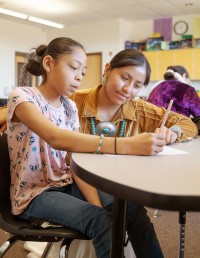Lau v. Nichols: A Watershed Supreme Court Ruling for the Rights of Non-English Speaking Students
On January 21, 1974, the United States Supreme Court unanimously sided with NCYL’s client, Kinney Kinmon Lau, in finding that the San Francisco Unified School District violated the law when it failed to provide language education to students who could not understand English. The Court’s decision, Lau v. Nichols, 414 U.S. 563 (1974), still stands today as a landmark case in the fight for equal education for students with limited English proficiency.
At the start of the lawsuit in March 1970, San Francisco public schools enrolled approximately 2800 students of Chinese descent who could not speak, understand, read, or write English. The school district offered no special instruction in English to approximately 1800 of these students. Roughly another 1000 students received some compensatory language education ranging from one to six hours a day. The plaintiffs in Lau represented both groups of students in their class action lawsuit against school district officials.
The U.S. District Court and the Ninth Circuit Court of Appeals each ruled against the plaintiff students. The District Court recognized that the plaintiffs were receiving essentially no education, stating at a hearing, “[T]hey are just bodies in the classroom. . . . [T]hey are named as students because it’s convenient, but since they are not studying and they are not learning . . . you can’t call them students.” Nevertheless, the District Court found the school district’s practices were not unlawfully discriminatory because the school district offered the same course of instruction to all students across the board. The Ninth Circuit affirmed the District Court’s denial of relief, emphasizing that the State had no duty to provide compensatory education and that, in the court’s view, the State had not caused the unequal situation Kinney and his peers faced.
The Supreme Court reversed the lower courts and ruled in the students’ favor. A program that does not teach non-English speaking students the skills they need to access their education “make[s] a mockery of public education[,]” the Supreme Court stated. The Supreme Court ruled that the school district’s actions violated the Civil Rights Act of 1964 (Title VI) as well as federal guidelines issued by the Department of Health, Education, and Welfare, which required federally funded school districts to “take affirmative steps to rectify . . . language deficiency in order to open its instructional program to . . . students” unable to speak and understand English. In so doing, the Supreme Court explained, “[T]here is no equality of treatment merely by providing students with the same facilities, textbooks, teachers, and curriculum; for students who do not understand English are effectively foreclosed from any meaningful education.”
Lau v. Nichols has since widely stood for the proposition that federally funded school districts must take affirmative steps to address language barriers facing students with limited English proficiency, and that “identical education does not constitute equal education under the Civil Rights Act of 1964.” The ensuing federal policy guidelines designed to implement the Supreme Court’s directive in the lawsuit are known today as the “Lau Remedies.”
NCYL (at that time called the Youth Law Center), Professor Edward Steinman of the University of Santa Clara School of Law, and the San Francisco Neighborhood Legal Assistance Foundation represented Kinney and the class of children. Marian Wright Edelman and Roger L. Rice, of the Center for Law and Education at Harvard University, served as amicus curiae on the case at the Ninth Circuit. Many additional amici curiae weighed in in support of Kinney when his case was pending before the Supreme Court.





